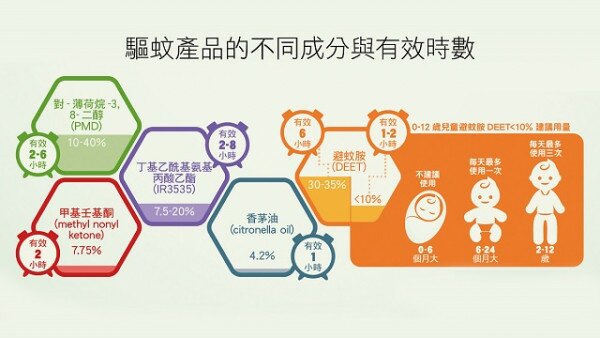Summer is not just a blissful season for the fans of outdoors activities, but also a time when mosquitoes are most active. Without sufficient precautionary measures, once steps outdoor one can easily become a feast for mosquitoes. The Consumer Council has analysed information of some of the mosquito repellents collected in the market to help consumers make the right choice.
Some major mosquito repelling ingredients found are diethyltoluamide (DEET), ethyl butylacetylaminoproprionate (IR3535), citronella oil, p-menthane-3,8-diol (PMD) and methyl nonyl ketone (IBI-246).
Mosquito repelling efficacy varies among different ingredients. Concentration of an ingredient impacts not on efficacy but on duration of protection. For instance, DEET, an ingredient in use for more than 50 years, remains effective for one to two hours at a concentration of less than 10%. The effect can last for as long as six hours when its concentration rises to between 30% and 35%. Besides, effect of mosquito repelling products can be influenced by activities such as skin rubbing, sweating and the environment where the user locates.
Consumer should also pay attention to the fact that some ingredients of mosquito repellent may cause adverse effects to the human body. For instance, it has long been questionable the safety level of DEET containing mosquito repellents, especially for children. There is not enough evidence to conclude that DEET affects children in particular. However, rash is a relatively common side-effect and excessive exposure to the ingredient may lead to seizures.
The Centre for Health Protection of the Department of Health in Hong Kong advised that concentration of DEET for adults and children should not exceed 35% and 10% respectively. Health Canada also suggests infants under six months should avoid using products contain DEET. It also recommends that products with less than 10% of DEET should not be applied on young children from 6 to 24 months for more than once a day. Children at the age of 2 to 12 should not use more than three times a day.
Through market survey of 45 different models of common anti-mosquito products in Hong Kong, including 31 models of mosquito repellents and 14 models of anti-mosquito patches, the Consumer Council found that some mosquito repellents in the market have not disclosed concentration of the mosquito repelling ingredients. Only anti-mosquito patches, which require registration, have concentration of the ingredients clearly listed on packaging. The Council believes that it is technically feasible to provide ingredient details and urges manufacturers and local agents to increase transparency by disclosing the ingredients and concentration on product labels for the benefit of an informed choice.
Citronella oil, which is generally regarded as a safe ingredient, also faces queries. Health Canada revealed Citronella oil-based products might contain the pollutant, methyl eugenol, and once intended to ban sales of these repellent products in local market in 2014. Health Canada subsequently conducted another review of mosquito repellents containing plant-derived essential oils and allowed sales of Citronella oil-based mosquito repellents in the meantime. This review is expected to be completed next year.
Methyl nonyl ketone (IBI-246) is a relatively new type of repellent ingredient among several commonly used products. Research indicated that IBI-246 is a natural substance extracted from tomatoes, which repels mosquitoes by upsetting their detection of carbon dioxide released from human body. US Environmental Protection Agency has classified IBI-246 under toxicity category IV, which means that it is safe, mild and virtually nontoxic. Some mosquito repellent products containing IBI-246 named this ingredient as "wild tomato extract".
When using DEET or IR3535-based mosquito repellents, consumers should beware that these ingredients may dissolve plastic materials and certain synthetic fibers. Touching your mobile phone, camera or plastic glasses frame directly with hands covered with such ingredients may cause unexpected damage to those items.
Mosquito repellents which are ready for home use and not for applying directly on human body, such as anti-mosquito patches, are regulated under the Pesticides Ordinance. On the other hand, those products to be directly applied on human body are not covered by this Ordinance, nor are they regarded as pharmaceutical products which are regulated under the Pharmacy and Poisons Ordinance.
The Consumer Council considers that whether the mosquito repellents are directly applied on human body or not, they should be regulated. Treating repellents to be used directly on human body merely as general consumer goods fails to provide sufficient consumer protection. The Council hopes to see more comprehensive regulations of mosquito repellent products.
Consumers are advised to take note of the following when applying mosquito repellents:
- DEET-based mosquito repellents should not be used on infants under 6 months. When using DEET-based mosquito repellents on young children, one should ensure that the concentration is less than 10%.
- Don't let children handle or apply mosquito repellent themselves.
- Avoid applying mosquito repellent to anywhere close to the eyes, mouth, wounds or sensitive skin of children.
- Sprays should only be used in open areas to avoid inhaling a large amount of it. Keep it away from fire.
- Children should wash the mosquito repellent off their skin after returning to the indoor area.
- Don't use mosquito repellent near food, and never grasp food or wipe eyes with a hand covered with mosquito repellent.
- Clothes applied with mosquito repellent should be cleaned up with soap and water.
The Consumer Council reserves all its right (including copyright) in respect of CHOICE magazine and Online CHOICE (https://echoice.consumer.org.hk/).



